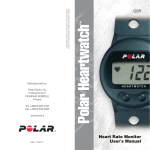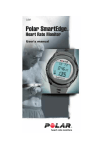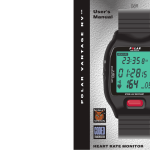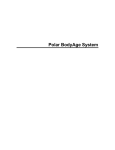Download Polar Electro GBR Specifications
Transcript
Contents How does Polar Favor work .................................................... 5 Polar Favor parts ...................................................... 5 Getting going ........................................................... 6 How to start heart rate measurement ..................................... 7 Functions during heart rate measurement .............................. 8 See your heart rate ................................................... 8 Turn the Target Zone sound signal on/off ................. 8 Stop heart rate measurement ................................... 8 How to set your Target Zone ................................................... 9 Exercising with your Polar Heart Rate Monitor ..................... 11 General exercise recommendation ........................ 12 Intensity of exercise ............................................... 12 Frequency of training ............................................. 15 Mode of activity ...................................................... 15 Structure of an exercise session ............................ 16 References ............................................................. 16 Quick guide for exercising .................................................... 17 Define the amount of your physical activity ........... 17 Determine your exercise goals .............................. 19 Examples of exercise recommendations ............... 19 Care and maintenance ......................................................... 21 Taking care ............................................................. 21 Batteries ................................................................. 22 Precautions ........................................................................... 23 In a water environment ........................................... 23 Interference ............................................................ 24 Frequently asked questions .................................................. 25 Technical specifications ........................................................ 27 Polar books and accessories ............................................... 28 Service .................................................................................. 29 Check list ................................................................ 29 Sending instructions ............................................... 30 Polar’s service procedure ....................................... 30 Limited Polar warranty .......................................................... 31 Disclaimer ............................................................................. 32 FAVOR manual GBR/E 2-3 16/1/01, 13:09 How does Polar Favor Work Congratulations on purchasing the Polar Favor Heart Rate Monitor. We are proud to assist you in achieving your personal fitness goals. This guide will provide you with the basic information on how to exercise with your Polar Heart Rate Monitor and how to get the best benefit of its functions. Wirelessly and continuously yours, POLAR FAVOR PARTS Your Polar Favor consists of three parts: VISUAL CUES TO READ THIS GUIDE 1. Polar T31™ Transmitter • Grooved electrode areas Indicates a tip to do things faster. Indicates important issues. Please, pay attention! Indicates a useful tip. It is good to know these things. 2. Elastic strap See also IMPORTANT TO REMEMBER! • Adjust the strap length snug enough and wet the transmitter electrodes to ensure flawless heart rate measurement. • Do not bend or stretch the transmitter. • Do not operate the buttons of the wrist receiver under water. • Wash and dry your transmitter regularly after use. • Do not store your Polar Heart Rate Monitor wet. Store it in a dry and cool place. • Keep the Polar Heart Rate Monitor out of extreme cold and heat. 3. Polar Favor Wrist Receiver 4 FAVOR manual GBR/E 5 4-5 16/1/01, 13:09 GETTING GOING 1. Attach the Polar Transmitter to the elastic strap. 2. Adjust the strap length to fit snugly and comfortably. 3. Secure the strap around your chest, below the chest muscles. Lock the buckle. Check that the Polar logo is in a central upright position. 4. Pull the Transmitter off your chest and wet the grooved electrode areas on the back of it. 5. Check that the wet electrode areas are firmly against your skin. 6. Wear the Wrist Receiver as you would wear an ordinary watch. Alternatively, if you go biking, you may attach the Wrist Receiver to a Polar Bike Mount. Polar Products. Keep the Wrist Receiver within the transmission range (1 metre / 3 feet). How to Start Heart Rate Measurement 1. Wear the Transmitter and the Wrist Receiver as described previously. 2. Press the left button of the Receiver for 1 second. Heart rate measurement commences and heart symbol starts flashing. Your heart rate (in beats per minute) appears in the display in approximately 5 seconds. The Target Zone sound symbol is on. 3. You can now start exercising with your Polar Favor. If you wish to wear a watch at the same time when exercising with Polar Favor, it is recommended that you wear the Polar Wrist Receiver and your watch on different wrists to avoid interference. It is recommended that you wear the Transmitter against your bare skin to ensure flawless operation. However, if you wish to wear the Transmitter over a shirt, moisten the shirt well under the electrodes. It is important that the electrodes are wet during exercise. After exercising to preserve the electrodes and battery life: 1. Wash the Transmitter carefully with a mild soap water solution. 2. Rinse it with pure water. 3. Dry the Transmitter carefully. 6 FAVOR manual GBR/E 7 6-7 16/1/01, 13:09 Functions During Heart Rate Measurement SEE YOUR HEART RATE You can see your heart rate in beats per minute. A flashing heart symbol indicates an ongoing heart rate measurement. The heart symbol flashes at the pace of your heart. How to Set Your Target Zone 1. When you start from the OFF display, press the left button once and you come to the heart rate measuring mode. 2. In the heart rate measuring mode, press the left button. The Upper Limit value and an arrow ( ) in the upper left corner of the display will appear. TURN THE TARGET ZONE SOUND SIGNAL ON/OFF When the Target Zone sound symbol appears in the display, you will hear an alarm sound with each heart beat if you go above the Upper Limit or below the Lower Limit of your Target Zone. 3. Keep pressing and hold the button to set the Upper Limit of your personal Target Zone. The numbers will descend in units of 5. Press the right button to turn the Target Zone sound signal on or off. sound signal is on 4. Release the button, when the desired Upper Limit is reached. The Lower Limit value and an arrow ( ) in the lower left corner of the display will appear. STOP HEART RATE MEASUREMENT Remove the Transmitter. Heart rate measurement stops. The Polar Favor Wrist Receiver will automatically return to the battery saving mode if no transmission signals are received within 10 minutes. OFF appears in the display. 8 FAVOR manual GBR/E 9 8-9 16/1/01, 13:09 5. Press and hold the left button to set the Lower Limit of your personal Target Zone. The numbers will ascend in units of 5. 6. Release the button, when the desired Lower Limit is reached. Polar Favor automatically enters the heart rate monitoring mode. The Upper Limit cannot be set below the Lower Limit. The Upper Limit value will automatically return to 240, the highest possible setting, when it drops to the Lower Limit value previously set. When the Lower Limit value reaches the Upper Limit value, the Lower Limit will be reset to 10, the lowest possible setting. It may be necessary to reduce the Lower Limit value first and then return to set the Upper Limit. Exercising with Your Polar Heart Rate Monitor Regular exercise helps you to sustain and improve your health and fitness, as well as feel better. Exercising has also other great benefits, you can reduce stress, learn to know your body’s reactions and optimise your training time. Whether you are about to start a regular exercise program or you already do sports training, a Polar Heart Rate Monitor will help you to achieve your personal fitness goals in less time, with greater safety. The effect of your exercise program depends on four factors: • Intensity of exercise • Duration of exercise • Frequency of exercise • Mode of activity Exercise may include some risk, especially for those who have been sedentary. To minimise possible risks consider the following advice. Before beginning a regular exercise program consult your doctor • if you are over 35 years of age • if you have not been following a regular exercise program during the past 5 years • if you smoke • if you have high blood pressure • if you have high blood cholesterol • if you have any signs or symptoms of any disease • if you are recovering from a serious illness or a medical treatment e.g. surgery • if you use a pacemaker or another implanted electronic device. 10 FAVOR manual GBR/E 11 10-11 16/1/01, 13:09 GENERAL EXERCISE RECOMMENDATION American College of Sports Medicine (ACSM 1990,1995) defines a recommended exercise dose for developing and maintaining cardiovascular fitness in healthy adults as follows: Intensity of training: Duration of training: 60-90% of the maximum heart rate 20-60 minutes of continuous aerobic activity Frequency of training: 3-5 days a week Mode of activity: Any mode which uses large muscle groups INTENSITY OF EXERCISE Heart rate is proved to be an excellent indicator of exercise intensity. Heart rate tells you the exertion level of your body during physical or mental loading. With the Polar Heart Rate Monitor you are able to follow the intensity of your exercise easily, keep yourself in the right heart rate Target Zone and stay motivated as you see the improvement. Changes in the heart’s beating rate can be followed with a Polar Heart Rate Monitor wirelessly, continuously and ECG accurately. If you aim for improved fitness or exercise for competitive reasons your exercise intensity is moderate or heavy paced, and it causes clear breathlessness and sweating. However, when planning your personal exercise dose, you can vary the workout intensity e.g. if there is a change in your physical condition or feelings. Target zones are calculated using the person’s maximum heart rate as a reference. The most reliable way to determine your individual Target Zone is to have your maximum heart rate measured at an exercise stress test. For more information on an exercise stress test, consult your physiologist or doctor. However, according to ACSM most people can estimate their maximum heart rate by the formula: 220 - Age = Maximum Heart Rate For example a 35-year old person’s Maximum Heart Rate would be: 220 - 35 = 185 beats per minute The following Target Range Chart helps you find the right Target Zone for your needs. The percentages for the Target Zones are counted from the maximum heart rate (measured or predicted). Define your exercise intensity according to your target. When you exercise within the defined Target Zone, you ensure the right intensity of your workout. Any physical activity that increases heart rate above the resting heart rate may provide health benefits, but only greater increments above resting heart rate are associated with both health and fitness benefits. This is why you should define your personal Target Zone. If you are a beginner, sedentary or overweight, a recommended target is to exercise at light or light to moderate intensity. At this target, the exercise is easy-paced and causes only slight breathlessness and sweating. 12 FAVOR manual GBR/E 13 12-13 16/1/01, 13:09 Example 1 Measured HRmax 190 185 180 175 170 165 160 155 150 185 180 175 170 165 160 35 40 45 50 55 60 1 Bpm Bpm 200 200 180 160 140 120 100 80 180 Heavy Intens ity 85-1 00% Modera te Inte nsity 7 0-85% Light to Moderat e Intens ity 60-70% Light Inte nsity 50-6 0% 160 20 25 30 35 40 45 50 55 60 65 120 Lower Limit Upper Limit 100 Lower Limit 80 70 How to find your personal Target Zone ? If you have had your maximum heart rate measured at an exercise stress test, use the upper axis for measured HRmax. This gives you the precise values for your Target Zone. In case you do not know your exact maximum heart rate, use the lower axis for age. 1. Locate one of the four intensity targets, which would be most suitable for you. Each target is shaded differently. 2. Locate your age on the down axis or your measured maximum heart rate on the upper axis. 3. Read up from your age / read down from your measured maximum heart rate to the target you chose. 4. Draw a straight line from the upper edge of the target to the left and you will find the Upper Limit of your Target Zone. 5. Then draw another straight line from the lower edge of the target to the left and you will find the Lower Limit for your Target Zone. 6. You have now found your Target Zone. As you exercise, make sure that your heart rate stays within your personal Target Zone (between the Lower and the Upper Limit) to get the maximum benefit from your workout. Upper Limit 140 Age Age 190 Measured HRmax 20 25 30 Example 2 See the examples above: 1. A person, whose maximum heart rate has been measured at an exercise stress test. His HRmax is 170 bpm and his goal is to exercise for health at Light to Moderate Intensity. The Target Zone limits are 102-119 bpm. 2. A person, who does not know his HRmax. He is 35 years old and his goal is to improve fitness at Moderate Intensity. The Target Zone limits are 130 - 157 bpm. FREQUENCY OF TRAINING It is recommended that you exercise 3-5 times a week. You can improve your performance by increasing the frequency of training. Remember to let your body recover properly between the training sessions. MODE OF ACTIVITY Select activities that you enjoy and vary your exercise modes. To build a solid base for your aerobic conditioning, choose continuous activities such as jogging, running, walking, swimming, bicycling, rowing and cross-country skiing. To improve your muscular endurance and strength as well as flexibility choose intermittent activities such as tennis, badminton, football, ice hockey, resistance training and gymnastics. 14 FAVOR manual GBR/E 15 14-15 16/1/01, 13:09 STRUCTURE OF AN EXERCISE SESSION Begin each workout slowly and give your body a chance to warm up for at least for 5 minutes so that your heart rate is below the selected Target Zone. Gradually increase the intensity of your exercise until you are in your Target Zone. Quick guide for exercising Remain in your Target Zone for the desired time. After that, gradually reduce the intensity of your exercise and let your heart rate fall below the Target Zone with a 5 minute cooldown period. Before beginning, you should ask yourself two key questions: • What is the amount of my physical activity at the moment? • What are my goals? For an example of an exercise session for a 35-year-old person with ‘Improved Fitness’ as a target, please see the following chart. The following steps help you answer the two questions, get the most out of your Polar Heart Rate Monitor, and achieve your personal exercise goals. 1. DEFINE THE AMOUNT OF YOUR PHYSICAL ACTIVITY Heart Rate/Beats Per Minute You may have a clear understanding of your present physical condition. In this case you can move to the next step to specify your goals. You can also define the amount of your physical activity by answering the questionnaire which is modified from the “Code for Physical Activity” developed by NASA/Johnson Space Center (Jackson et al. 1990). 150 TARGET ZONE 130 Resting Warm up 5-10 min cool down Target Zone 30-60 min Resting 5-10 min Minutes of exercise The questionnaire is an easy and quick way to define whether you are a beginner, a moderate exerciser, an active exerciser or a serious exerciser. It is recommended to review the questionnaire every 1-2 months and revise if the amount of your physical activity has changed. REFERENCES American College of Sports Medicine. Position Stand. The Recommended Quantity and Quality of Exercise for Developing and Maintaining Cardiorespiratory and Muscular Fitness in Healthy Adults. Med Sci Sports Exerc 22: 265-274, 1990. American College of Sports Medicine. ACSM’s Guidelines for Exercise Testing and Prescription. Williams & Wilkins, 1995. Jackson, A.S., Blair, S.N., Mahar, M.T., Wier, L.T., Ross, R.M. and Stuteville, J.E. Prediction of functional aerobic capacity without exercise testing. Med Sci Sports Exerc 22: 863-870, 1990. 16 FAVOR manual GBR/E 17 16-17 16/1/01, 13:09 Which alternative best describes your general activity level for the previous month? A beginner who does not participate regularly in programmed recreational sports or heavy physical activity. ❑ Avoid walking or exertion whenever possible. ❑ Walk for pleasure, routinely use stairs, occasionally exercise sufficiently to cause heavy breathing or perspiration. A moderate exerciser who participates regularly in recreation or work requiring modest physical activity, such as golf, gymnastics or yard work. 2. DETERMINE YOUR EXERCISE GOALS It is easier to stay motivated when you determine your reason for exercising and establish a goal. That is why you should determine your personal goal very clearly. Your exercise goal may be one of these: • • • • • • Get used to regular physical exercise Lose weight Maintain or improve health Maintain or improve fitness Compete with yourself Achieve competitive results 3. EXAMPLES OF EXERCISE RECOMMENDATIONS ❑ 10 to 60 min. a week Recommendation for a beginner: ❑ Over one hour a week Goal Duration in Target Zone Times a week Intensity Improve fitness and well-being 15-40 min. at a time 2-4 1 Light Light to moderate An active exerciser who participates regularly in heavy physical exercise such as jogging, swimming, cycling or engages in vigorous aerobic activity type exercise such as tennis. ❑ ❑ Run less than 1 mile a week or spend less than 30 min. a week in comparable physical activity. Run 1 to 5 miles a week or spend 30 to 60 min. a week in comparable physical activity. A serious exerciser who participates in a regimented workout program consisting of heavy physical exercise. ❑ Run 5 to 10 miles a week or spend 1 to 3 hours a week in comparable physical activity. ❑ Run over 10 miles a week or spend over 3 hours a week in comparable physical activity. Recommendation for a moderate exerciser: Goal Duration in Target Zone Times a week Intensity Maintain fitness and well-being 20-40 min. at a time 2-4 Light to moderate 1 Moderate Improve fitness and lose weight 30-60 min. at a time 2-4 Light to moderate 2 Moderate 18 FAVOR manual GBR/E 19 18-19 16/1/01, 13:09 Recommendation for an active exerciser: Goal Duration in Target Zone Times a week Intensity Maintain fitness and well-being 30-60 min. at a time 2-4 Moderate 1 Heavy Improve fitness 60-90 min. at a time 2-4 2 Moderate Heavy Care and Maintenance Your Polar Heart Rate Monitor is a high-tech instrument of superior design and workmanship and should be treated with care. The suggestions below will help you fulfill the warranty obligations and enjoy this product for many years to come. TAKING CARE OF YOUR POLAR HEART RATE MONITOR Recommendation for a serious exerciser: Have your maximum heart rate measured and find your personal Target Zone to get the best benefit of your training sessions. For more information on heart rate monitoring Polar products/Polar books and booklets. • Wash the Polar Transmitter regularly after use with a mild soap and water solution. Rinse with pure water. Dry carefully after washing. • Never store the Polar Transmitter wet. Sweat and moisture can keep its electrodes wet and the Polar Transmitter activated, which shortens the battery life. • Store your Polar Heart Rate Monitor in a cool and dry place. • Do not bend or stretch the Polar Transmitter. This may damage the electrodes. • Keep your Polar Heart Rate Monitor out of extreme cold (below -10 OC / 14 OF) and heat (above 50 OC / 122 OF). • Do not expose the Polar Heart Rate Monitor to direct sunlight for extended periods, such as by leaving it in a car. 20 FAVOR manual GBR/E 21 20-21 16/1/01, 13:09 BATTERIES POLAR TRANSMITTER The estimated average battery life of the Polar Transmitter is 2500 hours of use. Contact your distributor/dealer for a Transmitter replacement. See Service for detailed instructions. Polar recycles used Transmitters. POLAR WRIST RECEIVER The estimated average battery life of the Polar Wrist Receiver is 1 year in normal use (2h/day, 7 days a week). However, because the battery is inserted at the factory, the actual life of your first battery once in your possession may be less than the estimated battery life. Do not open the Polar Wrist Receiver yourself. To ensure the water resistance properties and the use of qualified components, the Wrist Receiver battery should be replaced only by a person authorised by Polar Electro Oy. At the same time a full periodic check of the Polar Heart Rate Monitor will be done. Service for detailed instructions. Precautions USING A POLAR HEART RATE MONITOR IN A WATER ENVIRONMENT Polar Favor is water resistant to 20 meters. To maintain the water resistance, do not operate the buttons of the Polar Wrist Receiver under water. The pressure may cause the Receiver to leak. Heart rate measurement in a water environment is technically demanding for the following reasons: • Pool water with a high chlorine content and seawater may be very conductive and therefore short circuit the ECG signal so that it cannot be detected by the Transmitter unit. • Jumping into the water or strenuous muscle movement during competitive swimming may cause water resistance that shifts the Transmitter on the body to a location where it is not possible to pick up ECG signal. • The ECG signal strength varies depending on the individual’s tissue composition and the percentage of people who have problems in heart rate measuring is considerably higher in a water environment than in other use. 22 FAVOR manual GBR/E 23 22-23 16/1/01, 13:09 POLAR HEART RATE MONITOR AND INTERFERENCE ELECTROMAGNETIC INTERFERENCE Disturbances may occur near high voltage power lines, televisions, cars, bike computers, some exercise equipment or cellular phones. CROSSTALK The non-coded Polar Wrist Receiver picks up transmitter signals within 1 metre/ 3 feet. Therefore, when you are using your Polar Heart Rate Monitor make sure no other transmitter is within that range. Signals from more than one transmitter picked up simultaneously can cause an incorrect readout. EXERCISE EQUIPMENT Several pieces of exercise equipment with electronic or electrical components such as LED displays, motors and electrical brakes may cause interfering stray signals. To try to tackle these problems, relocate the Polar Wrist Receiver as follows: 1. Remove the Polar Transmitter from your chest and use the exercise equipment as you would normally. 2. Move the Receiver around until you find an area in which it displays no stray reading or flashing of the heart symbol. Interference is often worst right in front of the display panel of the equipment, while the left or right side of the display is relatively free of disturbance. 3. Put the Transmitter back on the chest and keep the Receiver in this interference free area. 4. If the Polar Heart Rate Monitor still does not work with the exercise equipment, this piece of equipment may be too noisy electrically for wireless heart rate measurement. Notice for persons with pacemakers Persons who have a pacemaker use the Polar Heart Rate Monitor at their own risk. Before starting use, we always recommend an exercise test under doctor’s supervision. The test is to ensure the safety and reliability of the simultaneous use of the pacemaker and the heart rate monitor. Frequently Asked Questions WHAT SHOULD I DO IF... ...THERE IS NO HEART RATE READING? 1. Check that the elastic strap is snug enough. 2. Check that the electrodes of the Polar Transmitter are moistened and that you are wearing it as instructed. 3. Check that you have kept the Polar Transmitter clean. Care and maintenance. 4. Check that there are no sources of electromagnetic radiation in the close vicinity of the Polar Wrist Receiver, such as TV sets, cellular phones, CRT monitors etc. Precautions. 5. You can reset the Wrist Receiver by pressing both buttons down at the same time. The target zone limits enter the default settings. 6. Have you had a cardiac event which may have altered your ECG waveform? In this case consult your physician. ...HEART SYMBOL FLASHES IRREGULARLY? 1. Check that your Polar Wrist Receiver is inside the transmission range and not further that 1 metre/ 3 feet from the Polar Transmitter you are wearing. 2. Check that the elastic strap has not become loose during exercise. 3. Make sure that the electrodes of the Transmitter are moistened. 4. Make sure that there is no other heart rate transmitter within the reception range (1 metre/ 3 feet). Precautions/ Crosstalk. 5. Cardiac arrythmia may cause irregular readings. In this case consult your physician. 24 FAVOR manual GBR/E 25 24-25 16/1/01, 13:09 ...HEART RATE READING BECOMES ERRATIC OR EXTREMELY HIGH (OVER 200 BPM)? You may have come within range of strong electromagnetic signals which cause erratic readings on the Receiver display. Check your surroundings and move further away from the source of disturbance. Precautions. ...THE DISPLAY IS BLANK OR FADING? Have the batteries checked. Service. ...THE BATTERY OF THE WRIST RECEIVER MUST BE REPLACED? We recommend having all service done by authorised Polar Service. Especially during the warranty period this is necessary to keep the warranty of the whole Polar Heart Rate Monitor valid. Polar Service will test your Wrist Receiver for water resistance after battery replacement and make a full periodic check of the complete Polar Heart Rate Monitor. Care and Maintenance/Batteries and Service. Technical Specifications Polar Heart Rate Monitor is designed to indicate the level of physiological strain and intensity in sports and exercise. No other use is intended or implied. Heart rate is displayed as number of heart beats per minute (bpm). POLAR TRANSMITTER Battery type: Built-in Lithium Cell Battery life: Average 2500 hours of use Operating temperature: 14 OF to 122 OF / -10 OC to +50 OC POLAR WRIST RECEIVER Battery type: Battery life: Operating temperature: Water resistancy: Accuracy of heart rate measurement: CR 2032 Average 1 year (2h/day, 7 days/week) 14 OF to 122 OF / -10 OC to +50 OC to 20 metres ± 1% or ± 1 beats per minute, whichever larger, definition applies to steady state conditions DEFAULT SETTINGS Upper Limit: Lower Limit: 150 120 26 FAVOR manual GBR/E 27 26-27 16/1/01, 13:09 Polar Books and Accessories POLAR BOOKS AND BOOKLETS Roy Benson, MPE: ................. Precision Running Dr. Matthew Brick: .................. Precision Multisport Edmund R. Burke, Ph.D.: ....... Precision Cycling Neil Craig ............................... Scientific Heart Rate Training Sally Edwards: ....................... The Heart Rate Monitor Book Mark Fenton and Dave McGovern: .................... Precision Walking Ute Haas, M.Sc., Tarja Suomi, M.Sc. and Dr. Raija Laukkanen, Ph.D.: ... Precision Aerobics Dr. Peter J.G.M. Janssen: ...... Training, Lactate, Pulse Rate Dr. Katriina Kukkonen-Harjula, MD and Dr. Raija Laukkanen, Ph.D. ...................................... Precision Weight Management Dr. Raija Laukkanen, Ph.D ..... Research Index Yvonne Lin: ............................ Precision Sports Aerobics Dr. James M. Rippe: .............. Target Your Fitness and Weight Management Goals Dr. Jamer M. Rippe: ............... The Polar Fat Free and Fit Forever Program POLAR ACCESSORIES • • • • • Polar Bike Mount for all bikes and Polar Heart Rate Monitors Elastic straps of different lengths Extra Transmitter for other family members Polar Heart Bra for women Test handle for groups and trainers Service Polar Service will help you get the most out of your Polar Heart Rate Monitor. Should your Polar Heart Rate Monitor need service, please follow the instructions: CHECK LIST Before you return your Polar Heart Rate Monitor for service, please check the following: 1. IS THE TRANSMITTER BEING WORN CORRECTLY? The Polar logo should be right side up and the Transmitter flat against the skin. The elastic strap should be adjusted for a snug and comfortable fit. 2. ARE THE ELECTRODES MOIST ON THE TRANSMITTER? It is important that the electrodes are wet during the heart rate measurement. 3. IS THE TRANSMITTER CLEAN? Regular washing with mild soap and water solution and thorough dry afterwards will ensure that good conductivity remains. 4. ARE YOU HAVING DISTURBANCES CAUSED BY OTHER PEOPLE WITH HEART RATE MONITORS OR EXERCISE EQUIPMENT? Precautions/Polar Heart Rate Monitor and interference for more details. Ask your local dealer or distributor for more details. 28 FAVOR manual GBR/E 29 28-29 16/1/01, 13:09 SENDING INSTRUCTIONS 1. Pack the product carefully to avoid further damage. 2. Include all the parts of the Polar Heart Rate Monitor. A full periodic check will be done on the whole product. 3. Include proof of purchase (a receipt or its photocopy) if the product is under warranty. 4. Include a detailed description of the problem. Use the return sheet of the Customer Care Charter. 5. Include your name, return address and daytime telephone number. 6. Ship postage prepaid to your dealer or distributor. For contact details see the Customer Care Charter. POLAR’S SERVICE PROCEDURE Any service is recommended to be done by authorised Polar service personnel. Our standard test and check procedure will be performed to all Polar Heart Rate Monitors. The test includes following elements: POLAR TRANSMITTER 1. Visual inspection 2. Check of the transmission range 3. Check of electrode conductivity 4. Wash and clean if necessary Limited Polar Warranty • Polar Electro Oy warrants to the original consumer/ purchaser of this heart rate monitor that the product will be free from defects in material or workmanship for one year from the date of purchase. Please keep the receipt which is your proof of purchase! • Warranty does not cover receiver battery, damage due to misuse, abuse, accidents or negligence of the precautions; improper maintenance, commercial use, cracked or broken cases. • Warranty does not cover damage or consequential damage caused by service not authorized by Polar Electro. • During the warranty period the product will be either repaired or replaced at an authorised service centre free of charge. POLAR WRIST RECEIVER 1. Visual inspection 2. Check of battery voltage 3. Check and cleaning of case contacts 4. Re-assembly, including seal renewal if necessary 5. Water resistance test 6. Operational test Water resistance cannot be guaranteed after unauthorised service. • This warranty does not affect the consumer’s statutory rights under applicable national or state laws in force, or the consumer’s rights against the dealer arising from their sales/ purchase contract. Copyright © 1997, 2001 Polar Electro Oy, FIN-90440 KEMPELE, Finland Polar logotype is a registered trademark and Polar Favor is a trademark of Polar Electro Oy. 0537 This CE marking shows compliance of this product with Directive 93/42/EEC. 30 FAVOR manual GBR/E 31 30-31 16/1/01, 13:09 Disclaimer Notes This product is protected by one or several of the following patents: FI 88223, DE 4215549, FR 92.06120, GB 2257523, HK 113/1996, SG 9591671-4, US 5491474, FI 88972, FR 92.09150, GB 2258587, HK 306/1996, SG 9592117-7, US 5486818, FI 96380, US 5611346, FI 68734, DE 3439238, GB 2149514, HK 812/1989, US 4625733, FI 100924. The material in this manual is for informational purposes only. The products it describes are subject to change without prior notice, due to the manufacturer’s continuous development program. Polar Electro Oy makes no representations or warranties with respect to this manual or with respect to the products described herein. Polar Electro Oy shall not be liable for any damages, direct or incidental, consequential or special, arising out of, or related to, the use of this material or the products described herein. 32 FAVOR manual GBR/E 33 32-33 16/1/01, 13:09 Notes FAVOR manual GBR/E 34-35 16/1/01, 13:09 Recyclable material. Graphic design CIS, Kajaani, Finland GBR Polar Favor ™ Heart Rate Monitor User’s Manual Manufactured by: Polar Electro Oy Professorintie 5 FIN-90440 KEMPELE Finland Tel. +358-8-520 2100 Fax +358-8-520 2300 www.polar.fi 178281 GBR E 36 FAVOR manual GBR/E 36-37 16/1/01, 13:09


























